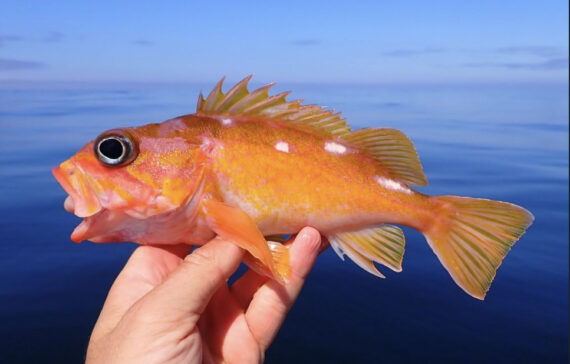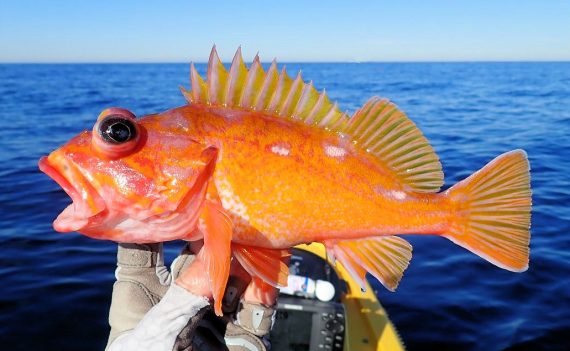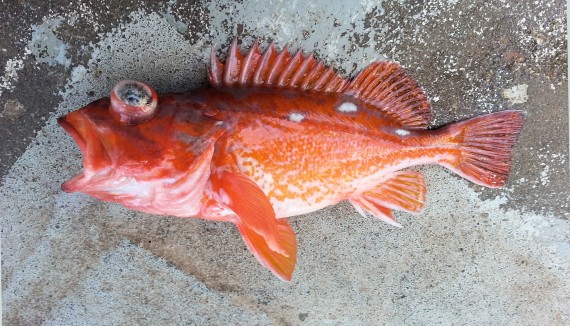Rosy Rockfish, Sebastes rosaceus
 Rosy Rockfish, Sebastes rosaceus. Fish provided by the commercial fishermen of the greater San Diego area, San Diego, California, December 2014. Length: 15 cm (5.9 inches). Identification courtesy of Milton Love, University of California Santa Barbara, Goleta, California.
Rosy Rockfish, Sebastes rosaceus. Fish provided by the commercial fishermen of the greater San Diego area, San Diego, California, December 2014. Length: 15 cm (5.9 inches). Identification courtesy of Milton Love, University of California Santa Barbara, Goleta, California.
 Rosy Rockfish, Sebastes rosaceus. Fish caught from coastal waters off Half Moon Bay, California, September 2023. Length: 20 cm (7.9 inches). Catch, photograph and identification courtesy of Ben Cantrell, Peoria, Illinois.
Rosy Rockfish, Sebastes rosaceus. Fish caught from coastal waters off Half Moon Bay, California, September 2023. Length: 20 cm (7.9 inches). Catch, photograph and identification courtesy of Ben Cantrell, Peoria, Illinois.
 Rosy Rockfish, Sebastes rosaceus. Fish caught from coastal waters off San Diego, California, November 2019. Length: 26 cm (10.3 inches). Catch, photograph and identification courtesy of Ben Cantrell, San Diego, California.
Rosy Rockfish, Sebastes rosaceus. Fish caught from coastal waters off San Diego, California, November 2019. Length: 26 cm (10.3 inches). Catch, photograph and identification courtesy of Ben Cantrell, San Diego, California.
 Rosy Rockfish, Sebastes rosaceus. Fish caught from coastal waters off Tijuana, Baja California, February, 2023. Length: 31 cm (12 inches). Catch, identification and photograph courtesy of Luke Ovgard, Klamath Falls, Oregon.
Rosy Rockfish, Sebastes rosaceus. Fish caught from coastal waters off Tijuana, Baja California, February, 2023. Length: 31 cm (12 inches). Catch, identification and photograph courtesy of Luke Ovgard, Klamath Falls, Oregon.
 Rosy Rockfish, Sebastes rosaceus. Fish caught from coastal waters off Ejido Eréndira, Baja California, February 2015. Catch, photograph and identification courtesy of Chris Wheaton, Fullerton, California. Identification reconfirmed by Milton Love, University of California, Santa Barbara, Goleta, California.
Rosy Rockfish, Sebastes rosaceus. Fish caught from coastal waters off Ejido Eréndira, Baja California, February 2015. Catch, photograph and identification courtesy of Chris Wheaton, Fullerton, California. Identification reconfirmed by Milton Love, University of California, Santa Barbara, Goleta, California.
The Rosy Rockfish, Sebastes rosaceus, is a member of the Rockfish and Scorpionfish or Scorpaenidae Family, and known in Mexico as rocote rosado. Globally, there are one hundred eight species in the genus Sebastes, of which fifty-three are found in Mexican waters, all in the Pacific Ocean.
The Rosy Rockfish is a small fish with wide body that has a depth that is 33% to 37% of standard length. They range in color from various shades of yellow, to red to a pale pink and striated with purple on the head and back. They have four to six white “squares” just below the dorsal fin, with pink and yellow fin membranes. The normally change colors quickly when collected to a deep red uniform coloration. The head is short with a short snout, large bulging eyes, a relatively small terminal mouth and is heavily covered with spines. Their anal fin has 3 spines and 5 to 7 rays; their caudal fin is square; their dorsal fin has 13 or 14 spines and 11 to 14 rays; and, their pectoral fins have 16 to 18 rays. They have 27 to 34 gill rakers. Their body is covered with scales.
The Rosy Rockfish is a demersal species that is found as solitary individuals or in small groups within rock structure that are found at depths between 8 m (25 feet) and 328 m (1,075 feet). They reach a maximum of 36 cm (14 inches) in length. They are found mixed in with Blue Rockfish, Pygmy Rockfish, Speckled Rockfish, Squarespot Rockfish and Starry Rockfish. They feed on benthic prey including fishes, crabs, shrimp and squid. Reproduction is oviparous with each female releasing between 12,600 and 95,000 pelagic eggs. They have life spans of up to fourteen years. The Rosy Rockfish is poorly studied with very limited information available about their lifestyle and behavioral patterns including specific details on age, growth, longevity, movement patterns, diet, habitat use, and reproduction.
The Rosy Rockfish is a resident of Mexican waters of the Pacific Ocean but has a limited distribution being found from Guerrero Negro, Baja California Sur, northward along the central and northwest coasts of Baja.
The Rosy Rockfish is difficult to identify and can be easily confused with the Pink Rockfish, Sebastes eos (lacks purple coloration), the Rosethorn Rockfish, Sebastes helvomaculatus (lacks purple coloration), and the Swordspine Rockfish, Sebastes ensifer (lacks purple coloration; exceedingly long second anal fin spine).
From a conservation perspective the Rosy Rockfish has not been formally evaluated. They are a moderately important commercial catch in California and are taken with gill nets and hook and line. The majority are sold to Asian markets and restaurants. They are also caught with regularity by recreational fishermen but are routinely discarded due to their small stature.